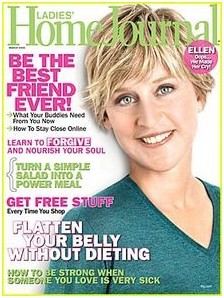
magazine Ladies' Home Journal
usinfo | 2013-06-26 12:02
| Ladies' Home Journal | |
 March 2009 cover of Ladies' Home Journal |
|
| Editor-in-chief | Sally Lee |
| Categories | Women's interest, lifestyle |
| Frequency | 11 issues/year |
| Publisher | Meredith Corporation |
|
Total circulation (2011) |
3,267,239[1] |
| First issue | 1883 |
| Country | USA |
| Language | English |
| Website | www.lhj.com |
| ISSN | 0023-7124 |
Ladies' Home Journal is an American magazine published by the Meredith Corporation. It first appeared on February 16, 1883, and eventually became one of the leading women's magazines of the 20th century in the United States. It was the first American magazine to reach 1 million subscribers in 1907.
Ladies' Home Journal is one of the Seven Sisters, a group of women's service magazines.
History
The Ladies' Home Journal arose from a popular single-page supplement in the American magazine Tribune and Farmer titled Women at Home. Women at Home was written by Louisa Knapp Curtis, wife of the magazine's publisher Cyrus H. K. Curtis.[2] After a year it became an independent publication with Knapp as editor for the first six years. Its original name was The Ladies Home Journal and Practical Housekeeper, but she dropped the last three words in 1886. It rapidly became the leading American magazine of its type, reaching a circulation of more than one million copies in ten years.[2]Edward W. Bok took over the editorship in late 1889 until 1919. Among features he introduced was the popular Ruth Ashmore advice column written by Isabel Mallon.[3] At the turn of the 20th century, the magazine published the work of muckrakers and social reformers such as Jane Addams. In 1901 it published two articles highlighting the early architectural designs of Frank Lloyd Wright.[4]
During World War II, it was a particularly favored venue of the government for messages intended for housewives.[5]
The Journal, along with its major rivals, Better Homes and Gardens, Family Circle, Good Housekeeping, McCall's, Redbook and Woman's Day were long known as the "seven sisters".[6] For decades, the Journal had the greatest circulation of this group, but it fell behind McCall's in 1961.[7] In 1968, its circulation was 6.8 million compared to McCall's 8.5 million. That year, Curtis Publishing sold the Ladies' Home Journal, along with the magazine The American Home, to Downe Communications for $5.4 million in stock.[8][9] Between 1969 and 1974 Downe was acquired by Charter Company,[10] which sold the magazine to Family Media Inc., publishers of Health, in 1982 when the company decided to divest its publishing interests. In 1986, the Meredith Corporation acquired the magazine from Family Media for $96 million.[11][12] By 1998, the Journal's circulation had dropped to 4.5 million.[13]
The Ladies' Home Journal's low subscription rates, inclusion of advertising to off-set costs, and reliance on popular content contributed to the publication's success. This operating structure was adopted by men's magazines like McClure's and Munsey's roughly a decade after it had become the standard practice of American women's magazines. Scholars argue that women's magazines, like the Ladies' Home journal, pioneered these strategies "magazine revolution".[14]
The magazine debuted an extensive visual and editorial redesign in its March 2012 issue. Photographer Brigitte Lacombe was hired to shoot cover photos, with Kate Winslet appearing on the first revamped issue. The Journal announced that portions of its editorial content would be crowdsourced from readers, who would be fairly compensated for their work.[15] The arrangement was one of the first of its kind among major consumer magazines.
Features
Knapp continued as editor until she was succeeded by Edward William Bok in 1889. However, she remained involved with the magazine's management, and she also wrote a column for each issue. In 1892, it became the first magazine to refuse patent medicine advertisements.[17] In 1896, Bok became Louisa Knapp's son-in-law when he married her daughter, Mary Louise Curtis.
The most famous cooking teacher of her time, Sarah Tyson Rorer served as LHJ first food editor from 1897 to 1911,[18] when she moved to Good Housekeeping.
In 1936, Mary Cookman, wife of New York Post editor Joseph Cookman began working at the Ladies' Home Journal. She was named Executive Editor and remained with LHJ until 1963.[19] She was known throughout most of her career as Mary Bass.
In 1946, LHJ adopted the slogan, "Never underestimate the power of a woman", which it continues to use today.[20]
The magazine's trademark feature is Can This Marriage Be Saved?, a popular column in which each person of a couple in a troubled marriage explains their view of the problem, a marriage counselor explains the solutions offered in counseling, and the outcome is published; it was written for 30 years starting in 1953 by Dorothy D. MacKaye under the name of Dorothy Cameron Disney.[21] MacKaye co-founded this column with Paul Popenoe, a founding practitioner of marriage counseling in the U.S. The two co-authored a book of the same name in 1960. Both the book and the column drew their material from the extensive case files of the American Institute of Family Relations in Los Angeles, California.[22]
Folded copy of The Ladies Home Journal and Practical Housekeeper (March 1886), founded and edited by Louisa Knapp Curtis
The illustrations of William Ladd Taylor were featured between 1895 and 1926; the magazine also sold reproductions of his works in oil and water-color.[23]
Share this page



















